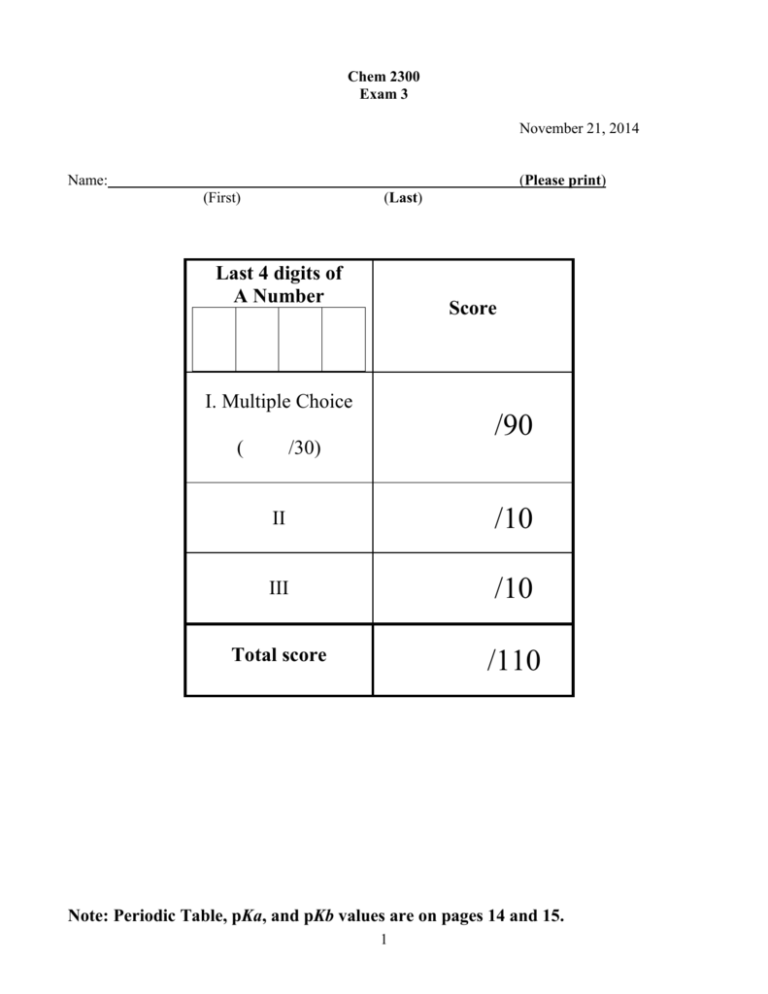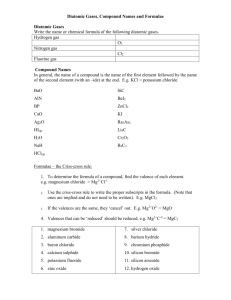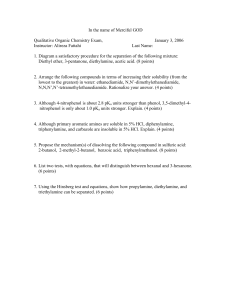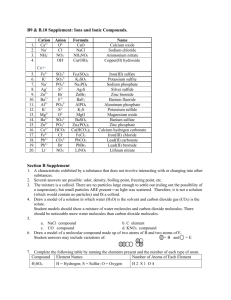Last 4 digits of A Number Score I. Multiple Choice ( /30) II III Total score
advertisement

Chem 2300 Exam 3 November 21, 2014 Name: (Please print) (First) (Last) Last 4 digits of A Number Score I. Multiple Choice ( /90 /30) II /10 III /10 Total score /110 Note: Periodic Table, pKa, and pKb values are on pages 14 and 15. 1 I. Multiple choice questions. (3 points each). Please put your answers on Scantron sheet. Your score will be graded based only on your answers from Scantron sheet. 1. What could be the substitution product for the following reaction? 2. What could be the substitution product for the following reaction? 3. Which statements are true for SN2 reaction of alkyl halides? I. Both of the alkyl halide and nucleophile are involved in the transition state. II. Reaction proceeds with inversion of configuration at the substitution center. III. Reaction proceeds via the formation of carbocation intermediate. IV. The order of reactivity is 1°>2°>3°. V. The nucleophile must have an unshared electron pair and bear a negative charge. VI. Protic solvents favor SN2 reaction. (a) II, IV, V (b) I, II, V, VI (c) III, V, VI (d) I, II, IV (e) None of the above 2 4. Which of the following alcohol would be least soluble in water? 5. What could be the product for the following reaction? 6. What could be the product for the following reaction? 3 7. What could be the product for the following reaction? 8. What is the possible mechanism for the reaction in Q.7? (a) SN1 (b) SN2 (c) E1 (d) E2 (e) None of the above 9. What could be the major product for the following reaction? 10. What is the name for the following compound? (a) (E)-N-ethyl-3-pentenamide (b) (Z)-N-ethyl-3-pentenamide (c) (E)-N-ethyl-4-pentenamide (d) (Z)-N-ethyl-4-pentenamide (e) None of the above 4 11. What is the name for the following compound? (a) (R)-3-methylhexanoic acid (b) (S)-3-methylhexanoic acid (c) (R)-3-methylhexyl acid (d) (S)-3-methylhexyl acid (e) None of the above 12. What is the name for the following compound? (a) cyclopentylcarbonyl chloride (b) cyclopentanecarbonyl chloride (c) cyclopentylacyl chloride (d) cyclopentaneacyl chloride (e) None of the above 13. What is the name for the following compound? (a) benzoyl chloride (b) benzyl chloride (c) benzene chloride (d) phenyl chloride (e) None of the above 14. The active ingredient in Tylenol is acetaminophen. Which of the following reagent cannot be used for the preparation of acetaminophen from 4-hydroxyaniline? (a) CH3COCl, N(CH2CH3)3 (b) (CH3CO)2O, N(CH2CH3)3 (c) CH3CO2CH3, heating (d) CH3CONH2, N(CH2CH3)3 (e) None of the above 5 N,N-Diethyl-meta-toluamide, abbreviated DEET, is a slightly yellow oil. DEET is the most common active ingredient in insect repellents developed by the United States Army, following the experience of jungle warfare during World War II. DEET can be prepared using m-toluic acid (3-methylbenzoic acid) as the starting material. Answer questions 15 - 16 based on the following scheme for the synthesis of DEET. 15. What should be the structure of I? 16. What could be reagent A? (a) (b) (c) (d) (e) Methylamine Dimethylamine Ethylamine Diethylamine None of the above 17. n-Octyl acetate is a commonly used artificial flavor to mimic orange flavor. What are the compounds required for the preparation of n-octyl acetate? (a) OH OH and O (b) OH and OH O (c) OH and OH O (d) OH OH and O (e) None of the above 6 18. One of the esters found in beeswax has the chemical formula of C15H31CO2C30H61. Which of the following synthetic scheme can be used to prepare this specific beeswax? 19. What could be the product for the following reaction? O NH (a) O HCl, H2O, heat Product? (c) (b) OH O H3 N (d) NH2 OH HO H2N Cl- O O (e) None of the above 7 O 2,4-Dichlorophenoxyacetic acid (2,4-D) is a common systemic pesticide/herbicide for controlling the growth of broadleaf weeds, such as dandelion. It can be synthesized from 2,4-dichlorophenol and chloroacetic acid. Answer questions 21-22. 20. What is the most likely reaction/mechanism for the synthesis of 2,4-D? (a) (b) (c) (d) (e) SN1 SN2 Electrophilic aromatic substitution Nucleophilic acyl substitution None of the above 21. What is the role of K2CO3 in the synthesis of 2,4-dichlorophenol? (a) (b) (c) (d) (e) electrophile nucleophile base solvent None of the above Based on the following reaction scheme, answer question 22 – 24. CN Br H H3C H H3C + CN- H + H3C CN I + Br- II 22. If this reaction goes through SN1 mechanism exclusively, what will be the ratio of compound I vs. compound II? (a) (b) (c) (d) (e) I/II = 50/50 I/II = 100/0 I/II = 0/100 I/II = 30/70 None of the above 8 23. If this reaction goes through SN2 mechanism exclusively, what will be the ratio of compound I vs. compound II? (a) (b) (c) (d) (e) I/II = 50/50 I/II = 100/0 I/II = 0/100 I/II = 30/70 None of the above 24. If 40% of the reaction goes through SN1 mechanism and 60% of the reaction goes through SN2 mechanism, what will be the ratio of compound I vs. compound II? (a) (b) (c) (d) (e) I/II = 80/20 I/II = 60/40 I/II = 40/60 I/II = 20/80 None of the above Answer Q. 25-27 based on the following scheme: 25. What is compound I? 9 26. What is compound II? 27. What is compound III? 28. What could be the product for the following reaction? 10 29. What could be the product for the following reaction? 30. What could be the product for the following reaction? Continue to the Next Page 11 II. Bio-diesel can be prepared by reacting fats or oils, for example, tripalmitoylglycerol with alcohols (methanol) under the catalysis of acids, a reaction known as transesterification. Propose an electronpushing mechanism for the formation of the bio-diesel shown in the following scheme. Note: you only need to show the conversion of one ester group. (10 points) O C H2C O O (CH2)14CH3 O H2C O O OH HC OH H2C OH H+ C HC H2C (CH2)14CH3 + 3 CH3OH C C (CH2)14CH3 glycerol tripalmitoylglycerol 12 O + 3 CH3O (CH2)14CH3 a bio-diesel III. (Bonus) Soaps can be prepared by hydrolysis of fats or oils, for example, tripalmitoylglycerol with base (NaOH), a reaction known as saponification. Propose an electron-pushing mechanism for the formation of the soap shown in the following scheme. Note: you only need to show the conversion of one ester group. (10 points) Next Pages: Periodic Table, pKa, and pKb Values 13 pKa Values for Selected Organic and Inorganic Acids Acid Formula pKa Conjugate Base Ethane CH3CH3 51 CH3CH2Ammonia NH3 38 NH2Ethanol CH3CH2OH 15.9 CH3CH2OWater H2O 15.7 HO+ Methylammonium ion CH3NH3 10.64 CH3NH2 Bicarbonate ion HCO310.33 CO32Phenol C6H5OH 9.95 C6H5OAmmonium ion NH4+ 9.24 NH3 Carbonic acid H2CO3 6.36 HCO3Acetic acid CH3CO2H 4.76 CH3CO2Benzoic acid C6H5CO2H 4.19 C6H5CO2Phosphoric acid H3PO4 2.1 H2PO4Hydronium ion H3O+ -1.74 H2O Sulfuric acid H2SO4 -5.2 HSO4Hydrogen chloride HCl -7 ClHydrogen bromide HBr -8 BrHydrogen iodide HI -9 I- 14 pKb Values for Selected Amines and pKa Values for Their Conjugate Acids Amine Formula/Structure pKb Conjugate Acid methylamine CH3NH2 3.36 CH3NH3+ ethylamine CH3CH2NH2 3.19 CH3CH2NH3+ dimethylamine (CH3)2NH 3.27 (CH3)2NH2+ diethylamine (CH3CH2)2NH 3.02 (CH3CH2)2NH2+ trimethylamine (CH3)3N 4.19 (CH3)3NH+ triethylamine (CH3CH2)3N 3.25 (CH3CH2)3NH+ NH2 pKa 10.64 10.81 10.73 10.98 9.81 10.75 NH3 aniline 9.37 4.63 NH2 4-methylaniline NH3 8.92 H3C 5.08 H3C NH2 4-chloroaniline NH3 9.85 Cl 4.15 Cl NH2 4-nitroaniline NH3 13.0 O 2N 1.0 O 2N H N pyridine N 8.75 H N H N imidazole 5.25 7.05 6.95 N N H 15








